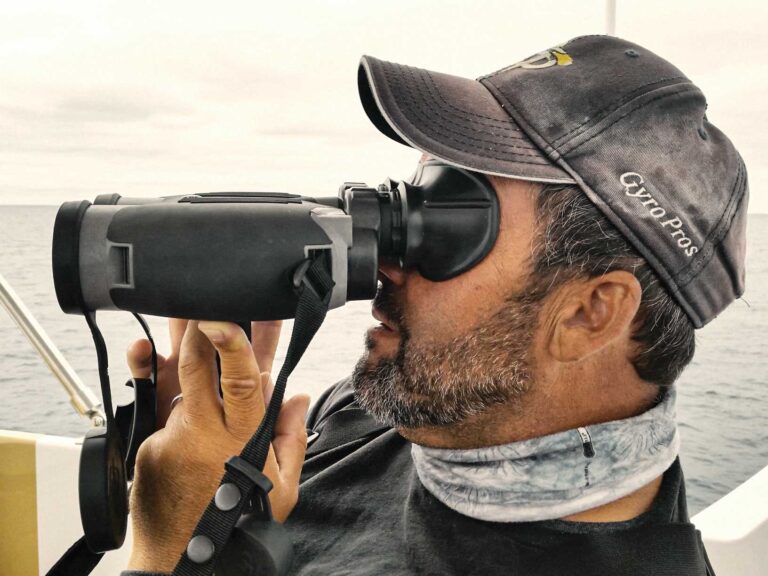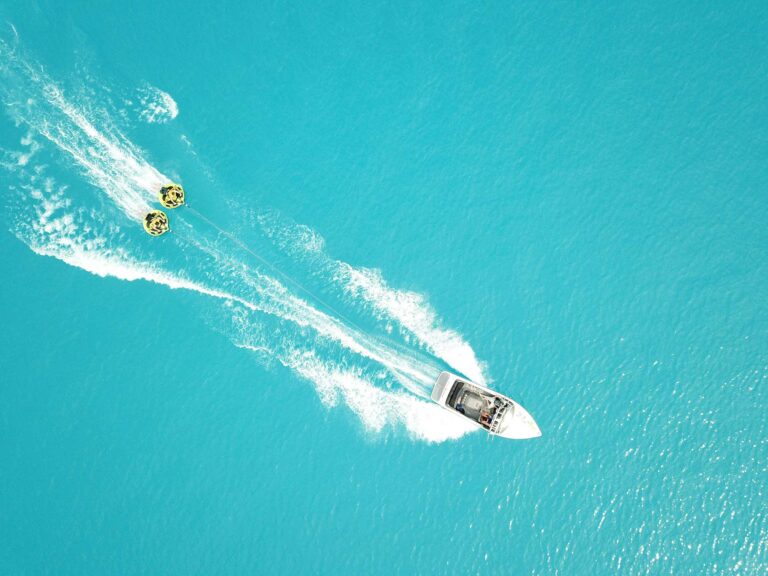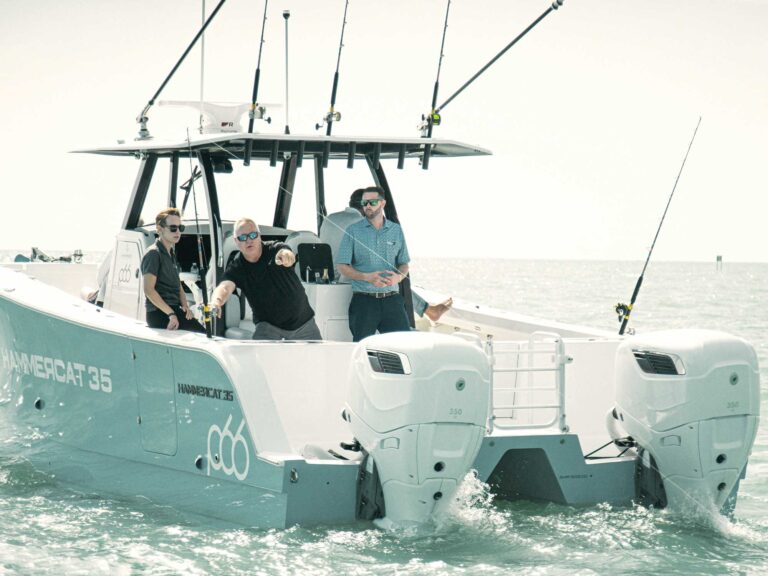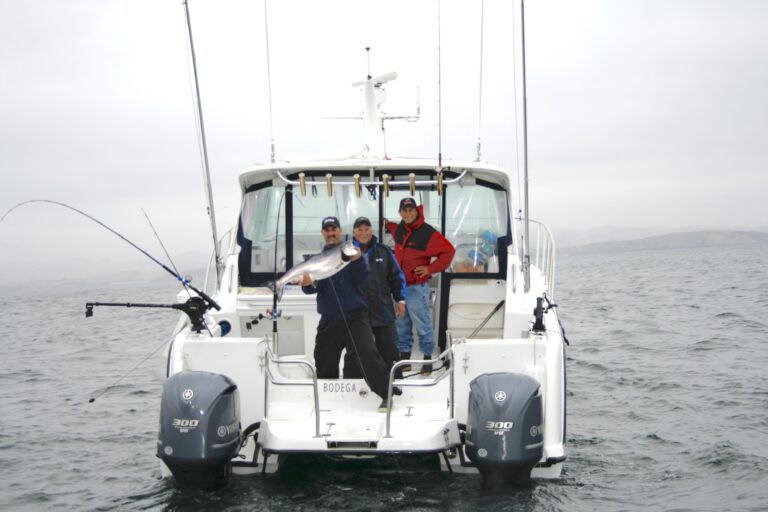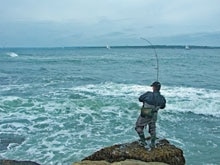
|| |—| || |Reacting quickly to a fish’s first run is the key to landing it. Photo: Laptewproductions.com| When novice surf anglers hook their first big fish, they usually find themselves in instant trouble. A few years ago I was fishing the ocean holes in Truro on Cape Cod, Massachusetts, with my good friend Ray and his wife Irene. She had never surf fished before, and her husband, a master at flyfishing the cliffs, was not familiar with big surf along a beach. I placed her in a good slot at the edge of a bar where the water was flowing hard along the beach – a typical flowing ocean hole in big surf. Casting a two-ounce tin with a medium-action nine-foot rod, Irene hooked what was obviously a big fish. In total panic she handed the rod to Ray who just stood there with bent rod as the fish smoked line, running with the flow along the beach. I reached her quickly, put the rod back in her hand, grabbed the back of her waders and started walking her down the beach.
There were several anglers down the shoreline and I yelled, “Big fish on, coming down.” The well-mannered anglers stopped casting and let us pass. It took about 150 yards of walking, but finally we were abreast of the fish. In this position the odds were now in our favor. The fish was straight out from us here and didn’t have the flow to work with. It made one more short run before we landed it. The bass weighed 42 pounds, a prize from the surf, and left us with plenty of memories.
Reacting swiftly to the first run is the key to landing fish from shore. If it is possible to follow a fish or to walk to a location that gives you an advantage, do it quickly. Staying close to a fish gives you better control and allows you to put more pressure on it. The more line you have in the water, the more likely something will go wrong: crossed lines, weed buildup or a fish burying itself in structure. Of course if the fish runs straight out to sea you can do little else but hang on.
It’s important to use enough tackle in tough conditions. Bigger surf often will create several problems: a strong flow down the slope of the beach and a hard flow along the beach, and sometimes water flow straight out to sea. Use a stout rod and at least 15-pound-test line in rolling surf – 20- to 25-pound-test line is even better if casting distance is not an issue.
Let’s look at some tough conditions that exist along the shore and the best ways to overcome them.
1. Jetty Jockeying
Trying to scuttle down the side of a slippery, rocky jetty to land a fish is difficult, dangerous and made worse by the wave action. When first hooked, big fish usually head for open water away from the structure. That’s your cue to begin walking toward shore as soon as the fish begins to run. Once you hit the beach, walk quickly away from the jetty because often the fish will try to get back to structure. With fly tackle the thick line is a drag on the fish and they often tire quickly with so much line out. The downside to this technique is the amount of line you must give to reach the beach. Weed buildup can be a problem.
But the tradeoff of fighting the fish on a flat beach is worth it.
If you plan to fish big jetties line capacity is important. Fill that spinning or fly reel with at least 200 yards of line – I prefer 250. Remember, it is more important to watch where you are walking than worry about the fish. If you need to address what the fish is doing, stop walking. If the top of the jetty is uneven move at a safe pace – it’s not worth getting hurt landing a fish. With smaller fish either slide them up the side or lift them. You should position yourself fairly close to the water when fishing so that landing smaller fish, though a nuisance, is not that difficult. Some anglers use small hand gaffs to lip-gaff fish and control them prior to release. But be sure to check local regulations before using a gaff.
2. Go With the Flow
Some flows along beaches are very strong. Good examples of this are the ocean holes along lower Cape Cod. In large surf these holes will flow hard. Another example is Cape Point off the Outer Banks where the water can flow like a river along the west section of beach.
There are two reasons to follow fish quickly. Staying close allows you to apply better pressure to the fish, and on crowded beaches there is less chance of becoming tangled with other anglers’ lines.
Let other anglers know that you have a fish on. At night yell loudly and move quickly before the fish gets too far down the beach. When following fish on steep beaches move up high, to a level section, so you can walk easily.
3. Put the Spurs to Them
Applying good pressure to a fish and keeping the fish off balance is one way to prevent them from reaching structure. When fishing around structure use heavy enough tackle to power the fish away from snags. Using low-stretch Spectra braid lines provides a distinct advantage when fishing structure. If a fish does reach structure and you can feel the line rubbing or the fish stops moving, slack off rod pressure. Sometimes if you apply just light pressure the fish will swim into open water. Several times I had big stripers swim off rocky locations using this technique, but it’s not as effective when using big multi-hooked plugs. Often the hook catches the bottom and the fish swims away leaving you stuck to the structure. If a grouper “rocks” you when fishing in tight structure try moving to get a better angle on the fish. I’ve pulled grouper from right under my feet by moving in close, letting the fish rest for several minutes, then with the rod tip in the water I put the boots to them. Along sheltered coral shorelines it works – sometimes.
4. First-Wave Power Punch
Wave action along steep beaches makes it much harder to land even mid-size fish. Waves rolling down the steep face of a beach have tremendous force. After bringing the fish close to shore you must cope with this water flowing down the face of the beach. Fish use this flow to help them swim – they stay sideways to the flow using their wide bodies to help them fight. The key is turning the fish headfirst toward the beach and punching it through the wave. The optimum time to do this is when there is a lull in the wave action or as a wave reaches the bottom of the trough. You will see the wave dissipate or you can feel the force diminish. Act quickly to turn the fish toward the beach by walking up the beach’s slope, or pulling with the rod. Be ready to give some ground on the next wave but by then the fish should be nearly beached. On the following wave you will need only moderate pressure to beach the fish. If you walk down the beach’s slope to grab the fish be aware of the waves so they don’t catch you off guard.
Landing fish from the surf in tough conditions takes practice. Fish stout tackle, be ready to move and have a plan before the fish hits.





